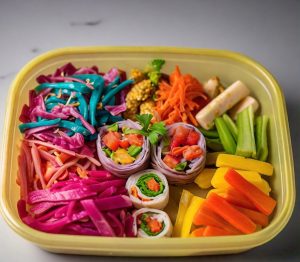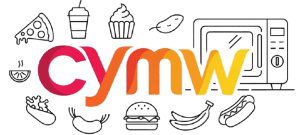Plastic is a synthetic material made from a wide range of organic polymers such as polyethylene, PVC, nylon, etc., that can be molded into shape while soft and then set into a rigid or slightly elastic form.
The question we are contemplating here is whether you can put it in the microwave or not.
This article includes details about plastic and its relationship with microwaving. Can you microwave plastic? If yes, for how long should it be microwaved without causing any damage to both the material and your appliance? And if not, what are some alternatives to using plastic in the microwave? Additionally, does heating destroy its structural integrity? We will discuss these points along with sharing tips and precautions when dealing with plastics in a microwave setting. Furthermore, we will explore frequently asked questions on this topic and conclude with our final thoughts.

Jump To:
Can Plastic Go in the Microwave?
Yes, certain types of plastic can indeed be microwaved. However, it’s crucial to ensure that the plastic is labeled “microwave safe” before using it in a microwave as not all plastics are created equal. Some may release harmful chemicals when heated, while others might melt or warp. Always check for the ‘microwave safe’ label or symbol on the container or its packaging prior to placing any plastic item in your microwave.
Check out if you can microwave a paper bag.
Facts About Plastics in the Microwave
Here we will discuss the important things to note about plastic and its compatibility with microwaves.
- Type of plastic: Not all plastics are microwave-safe. Some can release harmful chemicals when heated.
- Microwave-safe symbol: If a plastic container or wrap is labelled with a microwave-safe symbol, it’s specifically designed for microwave use.
- BPA-free: Avoid using containers made from polycarbonate (often marked with a number 7 or ‘PC’), these often contain Bisphenol-A (BPA) which may be harmful if ingested.
- Temperature limit: Different plastics have different melting points. Ensure that your food does not exceed this temperature to avoid molecular breakdown and potential chemical leakage into your food.
- PVC Plastic: Polyvinyl Chloride (PVC) plastics, often marked by the number 3 within the recycling triangle, should never be used in the microwave as they can release toxic dioxins when heated.
In conclusion, while some types of plastic are safe for microwave use, many others are not suitable due to potential health risks associated with heating them. Now, we will discuss some other aspects related to microwaving plastic items.
Check out if you can microwave a foam plate.
What are the Alternatives to Microwaving Plastic?
You have various alternatives when it comes to heating food without using plastic in a microwave. One of these includes using glass containers, which are not just safe for microwave use but also beneficial in retaining heat longer. You can also opt for ceramic containers as they are suitable and safe for microwave usage. Apart from this, another alternative could be paper plates or bowls, although their suitability would depend on the type of food being heated.
Tips to Microwave Safely Without Using Plastic
Here are a few useful tips to microwave baby Plastic:
- Always check if your container is labeled “microwave-safe” before use.
- Avoid heating foods with high oil or sugar content in non-microwave-safe containers as they reach higher temperatures faster.
- In case you have no other option than using plastic, ensure that the food doesn’t come into direct contact with it by placing a plate beneath or wrapping your food with wax paper.
- To prevent any harmful substances from leaching into your food while reheating, avoid overheating it beyond necessary temperatures.
- If there’s visible damage like cracking or clouding in your container— whether it be glass or ceramics—it’s best not to use them at all as these signs often indicate that safety properties might have been compromised over time.
We will now discuss FAQs on alternatives and tips regarding microwaving plastics safely in the next section.

Frequently Asked Questions (FAQs)
Next, we will delve into the most commonly asked questions regarding microwaving plastic items.
Can plastic go in the microwave?
Yes, certain types of plastic can go in the microwave. However, it’s crucial that they are labeled as “microwave-safe”. Such plastics have been tested and approved for use under microwave heat conditions.
What happens if you microwave non-microwave-safe plastic?
If you microwave non-microwave-safe plastic, it could melt or warp due to the high temperatures. Moreover, harmful chemicals might potentially leach into your food which is unsafe for consumption.
How can I recognize microwave-safe plastic?
Microwave-safe plastics generally have a symbol (squiggly lines forming a square) at their bottom. Always check this before microwaving any type of plastic container or product.
Is it safe to reheat food in plastic containers in the microwave?
It is safe to reheat food in plastic containers in the microwave only if those containers are specified as microwave-safe. Otherwise, consider transferring your food to a glass or ceramic dish that can withstand higher temperatures.
We conclude our FAQs section hoping these answers prove helpful in safely using your plastics with a microwave oven!
Final Word
In essence, while some forms of plastic are perfectly safe for use in microwaves, others should never be used due to potential health risks and damage to both the container and the appliance itself. Thus. always ensure you’re using ‘microwave-safe’ labelled products when heating up your meals! Stay safe and happy microwaving!



